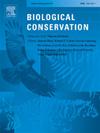Unraveling the non-linear associations between the international legal wildlife trade and biodiversity
IF 4.9
1区 环境科学与生态学
Q1 BIODIVERSITY CONSERVATION
引用次数: 0
Abstract
Biodiversity loss is one of the most critical challenges facing the world. International wildlife trade has led to large-scale wildlife migration, which directly impacts biodiversity. However, existing studies primarily focused on qualitative descriptions or linear quantitative characterizations of these impacts, lacking an understanding of non-linear associations. This study concentrated on international legal wildlife trade, calculating the quantity of legal wildlife trade among countries and elucidating the spatial patterns of global mammal, amphibian, bird, and fish biodiversity. Non-linear associations between legal wildlife trade and biodiversity and key countries were revealed using random forest regression models (RFR), generalized additive models (GAM), and network analysis. The results indicated that (1) Asia and North America had the most active legal wildlife trades; (2) Countries with high terrestrial biodiversity included those with large land areas such as the United States, Brazil, and China, while high fish biodiversity was found in coastal nations; (3) For mammals and amphibians, the sensitivity of biodiversity to total imported type was the highest, at 0.29 and 0.34, respectively, whereas for fish and birds, the sensitivity of biodiversity to total imported quantity was the highest, at 0.36 and 0.23, respectively; (4) Biodiversity increased with the quantity/type of trade imports, showing a clear non-linear association, and countries like United States, China and Germany played a significant role in the associations between wildlife trade network and biodiversity. This study provided crucial support for future global wildlife conservation and trade policy decisions.
求助全文
约1分钟内获得全文
求助全文
来源期刊

Biological Conservation
环境科学-环境科学
CiteScore
10.20
自引率
3.40%
发文量
295
审稿时长
61 days
期刊介绍:
Biological Conservation is an international leading journal in the discipline of conservation biology. The journal publishes articles spanning a diverse range of fields that contribute to the biological, sociological, and economic dimensions of conservation and natural resource management. The primary aim of Biological Conservation is the publication of high-quality papers that advance the science and practice of conservation, or which demonstrate the application of conservation principles for natural resource management and policy. Therefore it will be of interest to a broad international readership.
 求助内容:
求助内容: 应助结果提醒方式:
应助结果提醒方式:


